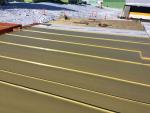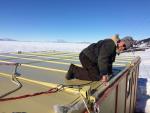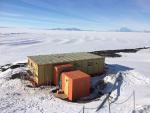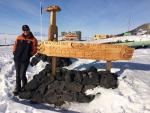Hillary’s Hut
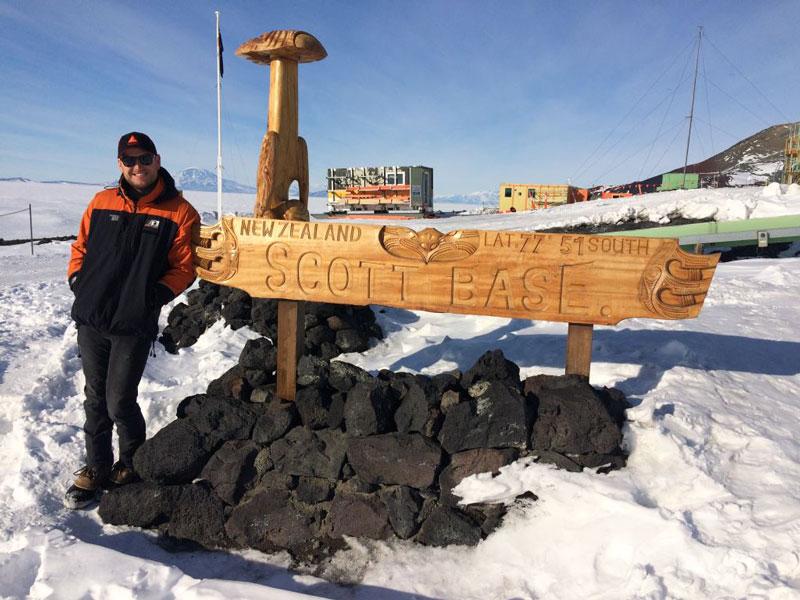
Re-roofing Hillary’s hut at Scott Base
An iconic piece of New Zealand’s history – Sir Edmund Hillary’s hut at Scott Base – has been completely restored with roofing and cladding installed late last year by specialist standing seam roofer Mike Burgess, who talks to Jenny Bain. The hut is an important link to Hillary’s famous tractor trip to the South Pole and was built under his guidance by his team in 1957, now sitting among a group of flat-roofed buildings making up New Zealand’s scientific facility at Scott Base. Restoration of the hut – also known as the TAE/IGY hut – has been the responsibility of the Antarctic Heritage Trust (AHT) which cares for all the expedition bases of historical significance on the Ross Sea built by explorers Borchgrevink, Scott, Shackleton and Hillary.
Largely used for storage since it became uninhabitable in the 1980s, the hut has undergone total restoration over the Antarctic summers of 2016 and 2017 after $1 million was raised by the trust to bring the building back to life. Under guidance from conservation architect, Pip Cheshire of Cheshire Architects, Hillary’s hut has been painstakingly restored, ensuring the preservation of precious artefacts from the era of early exploration. Well known to architects for his knowledge and skill in the secret fix, European style of roofing, Mike was the installer of choice for the final stage of the restoration project, having worked recently with Cheshire Architects on Dune House, a private residence at Tara Iti and SKHY apartments in Khyber Pass, Auckland. Mike can attest to the significance and privilege of being assigned for this work at the South Pole. As Project Manager for RANZ member Architectural Metalformers, it was agreed that Mike’s time and all services required to complete the task including provision and transport of materials and accessories, manufacturing time and technical input would be donated to the trust for the project.
Pacific Coilcoaters provided their ColorCote® AlumiGard™ product in 1200mm wide 0.9mm 5005H34 aluminium and Akzo Nobel, one of Pacific Coilcoaters’ key paint suppliers, made a special one-off drum of paint to match the original colour of the hut. Architectural Metalformers manufactured the sheets. Julian Wai from Pacific Coilcoaters assisted Mike in the decision making on the material to ensure a product was chosen to be malleable enough in such extreme conditions. Sika New Zealand and Nexus Foams also donated materials for the project, foam being specified to inhibit any possible water ingression from melting snow through the standing seam sheets. This consignment of materials was air lifted to Scott Base to await Mike’s arrival.
From the get-go Mike was fully absorbed in the various design aspects “required to be sympathetic to the AHT brief to match the original building” for a painted, waterproof aluminium roof with new vertical battens painted in the original bright orange. New macrocarpa battens were cut and painted to give the original look of the hut without compromising their integrity.
During last season’s remedial works all the asbestos was removed from the interior of the hut and the AHT built a new plywood roof over the existing old roof so if required in the future, and if new materials or sealants are available, they could remove Mike’s new roof and fix the lower roof. Mike said this was interesting as he needed to mark up all products with AHT 17/18 so any future conservators knew what to save or what to remove in the future. The brief for AHT is to always preserve as much originality to the buildings as possible, therefore when the original strong backs could be reused over Mike’s new roof those remained.
The original hut had been modulated in Australia and flown via Christchurch to Scott Base for Hillary to assemble as living quarters. It was fully water proofed and robust at the time but the ravages of the Antarctic climate had rendered it uninhabitable. Twentieth century materials and systems should see the roof last 35 years but it will likely last 50 – 100 years according to Al Fastier, the programme manager for the trust.
Mike flew to Scott Base on November 13 in a US Airforce C-17 Globemaster in prestigious company. His fellow passengers included the US Ambassador to New Zealand, Scott Brown, the head of the US based National Science Foundation along with its board of directors and a four-star US general, second in charge of the US Pacific fleet based in Honolulu. Flight duration was 5 ½ hours.
It may have been “summer” in Antarctica but Mike was to immediately discover some challenges ahead to install a new roof in sub-zero temperatures.
Says Mike: “Nothing can prepare you for the challenge of working in temperatures that averaged from minus 8 to minus 15 degrees but on some days dropped to minus 30 degrees. I was completely kitted out from head to toes in Antarctic New Zealand gear and this requires excessive layering of the under garments. I would have a base layer, two middle layers and then an outer jacket: depending on the temperature you may wear your ECW (extreme cold weather) gear which is normally reserved for expeditions off the base.
“Assisting me on the re-roof was Antarctic Youth Ambassador from the Sir Peter Blake Trust, engineer Chris Ansin. We would check the weather at our daily toolbox meeting and layer our clothing accordingly right down to leggings, footwear, boots, buffer goggles, beanies and gloves.
“There were days when I had to sacrifice being warm to achieve the perfection the job required. As an example, although we had gloves they would often be too restrictive and I would work with bare hands for a limited amount of time before they started to freeze. Then I would crack hand-warming gel packs and keep them in my pockets to warm up my hands as required.
“The kit alone weighs 10kg so add to that a tool belt and harness – we had to walk back and forth from Hillary’s hut to where we were folding the aluminium sheets (using a Wuko tool) at the Hillary Field Centre 500m away. We had to carry the sheets over to the roof each time as they can’t be left on the snow and sometimes we needed to peel off layers of clothing rather than add layers. It certainly was an exercise in tolerance.
“Yet here I was in this magnificent environment, sharing the mystique and aura of Scott Base and Ross Island. I am well and truly bitten by this opportunity to work on something of such importance to New Zealand. A backdrop to the base is Mt Erebus which puffs away and I was there for the memorial to AirNZ flight 901 which crashed on the mountain on 28 November 1979.”
Mike seized this once in a lifetime opportunity to immerse himself in the Antarctic experience during his 13 days on Scott Base, six of which were taken up with completing the hut. Twenty-four hours of daylight meant evenings could be spent exploring beyond the base. Mike completed the obligatory Antarctic field training (digging a camp in ice, sleeping on the ice in a polar tent, setting up an ice kitchen) and was then able to venture to Observation Hill or the US base at McMurdo Sound, 45 minutes away. On these night excursions he was able to ice climb to explore caves on the Erebus Glacial Tongue, walk the Pressure Ridges to view giant fissures and cracks rising up out of the ice shelf, also taking in Castle Hill and Crater Rock. It was all about absorbing what life must have been like for those early pioneers.
Adding to Mike’s experience, Nigel Watson, chairman of the Antarctic Heritage Trust, accompanied Mike on a tour of all the expedition huts including the original Discovery hut for a privileged view of the historical artefacts – mutton carcasses still hanging, biscuits in a remarkable state of preservation – even food still perfectly preserved on the stove top from the day the last inhabitants ventured out into the cold and never returned.

